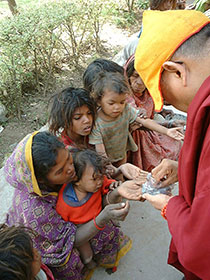- Home
- FPMT Homepage
Foundation for the Preservation of the Mahayana Tradition
The FPMT is an organization devoted to preserving and spreading Mahayana Buddhism worldwide by creating opportunities to listen, reflect, meditate, practice and actualize the unmistaken teachings of the Buddha and based on that experience spreading the Dharma to sentient beings. We provide integrated education through which people’s minds and hearts can be transformed into their highest potential for the benefit of others, inspired by an attitude of universal responsibility and service. We are committed to creating harmonious environments and helping all beings develop their full potential of infinite wisdom and compassion. Our organization is based on the Buddhist tradition of Lama Tsongkhapa of Tibet as taught to us by our founders Lama Thubten Yeshe and Lama Thubten Zopa Rinpoche.
- Willkommen
Die Stiftung zur Erhaltung der Mahayana Tradition (FPMT) ist eine Organisation, die sich weltweit für die Erhaltung und Verbreitung des Mahayana-Buddhismus einsetzt, indem sie Möglichkeiten schafft, den makellosen Lehren des Buddha zuzuhören, über sie zur reflektieren und zu meditieren und auf der Grundlage dieser Erfahrung das Dharma unter den Lebewesen zu verbreiten.
Wir bieten integrierte Schulungswege an, durch denen der Geist und das Herz der Menschen in ihr höchstes Potential verwandelt werden zum Wohl der anderen – inspiriert durch eine Haltung der universellen Verantwortung und dem Wunsch zu dienen. Wir haben uns verpflichtet, harmonische Umgebungen zu schaffen und allen Wesen zu helfen, ihr volles Potenzial unendlicher Weisheit und grenzenlosen Mitgefühls zu verwirklichen.
Unsere Organisation basiert auf der buddhistischen Tradition von Lama Tsongkhapa von Tibet, so wie sie uns von unseren Gründern Lama Thubten Yeshe und Lama Thubten Zopa Rinpoche gelehrt wird.
- Bienvenidos
La Fundación para la preservación de la tradición Mahayana (FPMT) es una organización que se dedica a preservar y difundir el budismo Mahayana en todo el mundo, creando oportunidades para escuchar, reflexionar, meditar, practicar y actualizar las enseñanzas inconfundibles de Buda y en base a esa experiencia difundir el Dharma a los seres.
Proporcionamos una educación integrada a través de la cual las mentes y los corazones de las personas se pueden transformar en su mayor potencial para el beneficio de los demás, inspirados por una actitud de responsabilidad y servicio universales. Estamos comprometidos a crear ambientes armoniosos y ayudar a todos los seres a desarrollar todo su potencial de infinita sabiduría y compasión.
Nuestra organización se basa en la tradición budista de Lama Tsongkhapa del Tíbet como nos lo enseñaron nuestros fundadores Lama Thubten Yeshe y Lama Zopa Rinpoche.
A continuación puede ver una lista de los centros y sus páginas web en su lengua preferida.
- Bienvenue
L’organisation de la FPMT a pour vocation la préservation et la diffusion du bouddhisme du mahayana dans le monde entier. Elle offre l’opportunité d’écouter, de réfléchir, de méditer, de pratiquer et de réaliser les enseignements excellents du Bouddha, pour ensuite transmettre le Dharma à tous les êtres. Nous proposons une formation intégrée grâce à laquelle le cœur et l’esprit de chacun peuvent accomplir leur potentiel le plus élevé pour le bien d’autrui, inspirés par le sens du service et une responsabilité universelle. Nous nous engageons à créer un environnement harmonieux et à aider tous les êtres à épanouir leur potentiel illimité de compassion et de sagesse. Notre organisation s’appuie sur la tradition guéloukpa de Lama Tsongkhapa du Tibet, telle qu’elle a été enseignée par nos fondateurs Lama Thoubtèn Yéshé et Lama Zopa Rinpoché.
Visitez le site de notre Editions Mahayana pour les traductions, conseils et nouvelles du Bureau international en français.
Voici une liste de centres et de leurs sites dans votre langue préférée
- Benvenuto
L’FPMT è un organizzazione il cui scopo è preservare e diffondere il Buddhismo Mahayana nel mondo, creando occasioni di ascolto, riflessione, meditazione e pratica dei perfetti insegnamenti del Buddha, al fine di attualizzare e diffondere il Dharma fra tutti gli esseri senzienti.
Offriamo un’educazione integrata, che può trasformare la mente e i cuori delle persone nel loro massimo potenziale, per il beneficio di tutti gli esseri, ispirati da un’attitudine di responsabilità universale e di servizio.
Il nostro obiettivo è quello di creare contesti armoniosi e aiutare tutti gli esseri a sviluppare in modo completo le proprie potenzialità di infinita saggezza e compassione.
La nostra organizzazione si basa sulla tradizione buddhista di Lama Tsongkhapa del Tibet, così come ci è stata insegnata dai nostri fondatori Lama Thubten Yeshe e Lama Zopa Rinpoche.
Di seguito potete trovare un elenco dei centri e dei loro siti nella lingua da voi prescelta.
- 欢迎 / 歡迎
简体中文
“护持大乘法脉基金会”( 英文简称:FPMT。全名:Foundation for the Preservation of the Mahayana Tradition) 是一个致力于护持和弘扬大乘佛法的国际佛教组织。我们提供听闻,思维,禅修,修行和实证佛陀无误教法的机会,以便让一切众生都能够享受佛法的指引和滋润。
我们全力创造和谐融洽的环境, 为人们提供解行并重的完整佛法教育,以便启发内在的环宇悲心及责任心,并开发内心所蕴藏的巨大潜能 — 无限的智慧与悲心 — 以便利益和服务一切有情。
FPMT的创办人是图腾耶喜喇嘛和喇嘛梭巴仁波切。我们所修习的是由两位上师所教导的,西藏喀巴大师的佛法传承。
繁體中文
護持大乘法脈基金會”( 英文簡稱:FPMT。全名:Found
ation for the Preservation of the Mahayana Tradition ) 是一個致力於護持和弘揚大乘佛法的國際佛教組織。我們提供聽聞, 思維,禪修,修行和實證佛陀無誤教法的機會,以便讓一切眾生都能 夠享受佛法的指引和滋潤。 我們全力創造和諧融洽的環境,
為人們提供解行並重的完整佛法教育,以便啟發內在的環宇悲心及責 任心,並開發內心所蘊藏的巨大潛能 — 無限的智慧與悲心 – – 以便利益和服務一切有情。 FPMT的創辦人是圖騰耶喜喇嘛和喇嘛梭巴仁波切。
我們所修習的是由兩位上師所教導的,西藏喀巴大師的佛法傳承。 察看道场信息:
- FPMT Homepage
- News/Media
-
- Study & Practice
-
-
- About FPMT Education Services
- Latest News
- Programs
- New to Buddhism?
- Buddhist Mind Science: Activating Your Potential
- Heart Advice for Death and Dying
- Discovering Buddhism
- Living in the Path
- Exploring Buddhism
- FPMT Basic Program
- FPMT Masters Program
- FPMT In-Depth Meditation Training
- Maitripa College
- Lotsawa Rinchen Zangpo Translator Program
- Universal Education for Compassion & Wisdom
- Online Learning Center
-
- Prayers & Practice Materials
- Overview of Prayers & Practices
- Full Catalogue of Prayers & Practice Materials
- Explore Popular Topics
- Benefiting Animals
- Chenrezig Resources
- Death & Dying Resources
- Lama Chopa (Guru Puja)
- Lama Zopa Rinpoche: Compendium of Precious Instructions
- Lama Zopa Rinpoche: Life Practice Advice
- Lama Zopa Rinpoche Practice Series
- Lamrim Resources
- Mantras
- Prayer Book Updates
- Purification Practices
- Sutras
- Thought Transformation (Lojong)
- Audio Materials
- Dharma Dates - Tibetan Calendar
- Translation Services
- Publishing Services
- Ways to Offer Support
- Prayers & Practice Materials
-
- Teachings and Advice
- Find Teachings and Advice
- Lama Zopa Rinpoche Advice Page
- Lama Zopa Rinpoche: Compendium of Precious Instructions
- Lama Zopa Rinpoche Video Teachings
- ༧སྐྱབས་རྗེ་བཟོད་པ་རིན་པོ་ཆེ་མཆོག་ནས་སྩལ་བའི་བཀའ་སློབ་བརྙན་འཕྲིན།
- Podcasts
- Lama Yeshe Wisdom Archive
- Buddhism FAQ
- Dharma for Young People
- Resources on Holy Objects
- Teachings and Advice
-
-
*If a menu item has a submenu clicking once will expand the menu clicking twice will open the page.
-
-
- Centers
-
- Teachers
-
- Projects
-
-
-
-
*If a menu item has a submenu clicking once will expand the menu clicking twice will open the page.
-
-
- FPMT
-
-
-
-
-
If your daily life is tremendously involved in emotions, you are completely driven by them and psychologically tired. In other words, our physical emotions get too involved and we don’t understand the functioning of our six sense consciousnesses.
Lama Thubten Yeshe
-
-
-
- Shop
-
-
-
The Foundation Store is FPMT’s online shop and features a vast selection of Buddhist study and practice materials written or recommended by our lineage gurus. These items include homestudy programs, prayers and practices in PDF or eBook format, materials for children, and other resources to support practitioners.
Items displayed in the shop are made available for Dharma practice and educational purposes, and never for the purpose of profiting from their sale. Please read FPMT Foundation Store Policy Regarding Dharma Items for more information.
-
-
Mandala
25
Bob Brintz Writes ‘On Hope’
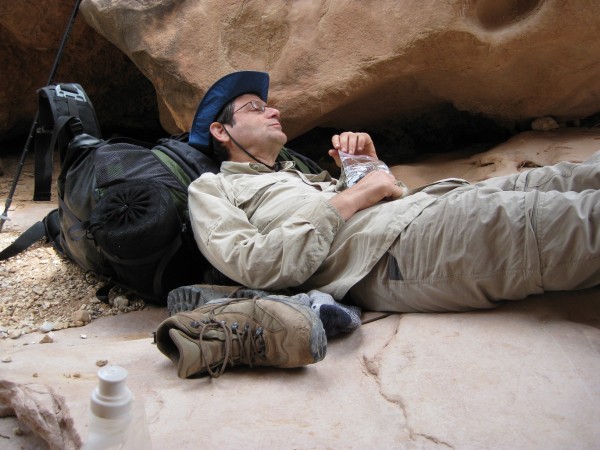
Bob Brintz rests in the Grand Canyon, United States, a year after being diagnosed with ALS (Lou Gehrig’s disease). Photo courtesy of Bob Brintz.
Student Bob Brintz lives with ALS (Lou Gehrig’s disease) and is almost completely paralyzed. Through his writings on the website patientslikeme.com, borrowing heavily from Buddhist teachings, he tries to encourage other ALS patients (PALS) that they too can transform their way of thinking to one that allows joyful living with ALS. Bob was featured in the Mandala July-September 2013 print edition in his article “I Will Be Paralyzed and Happy.”
In a recent response to a 2006 post on the PatientsLikeMe ALS forum, member David, who was diagnosed with bulbar onset motor neuron disease in June 2012, asks, in regard to patients opting not to engage in a battery of life-extending interventions, “How do we want to spend our remaining years and months? If we choose not to fight, are we giving up? Do we love life less?” He ended his post with a quote from Friedrich Nietzsche, the 19th-century German philosopher: “Hope, in reality, is the worst of all evils because it prolongs the torments of man.”
Bob responds in “A Path to Survival III: On Hope”:
“ … I feel compelled to reply to David because I believe that his thoughts are shared by many other PALS and they strike me as being in some respects illogical. In saying this, I don’t intend to be judgmental or critical of anyone. My only objective is to help other PALS find their path to survival, if they so choose, as I have found mine.
“… Nietzsche’s was certainly not a philosophy of hopelessness and despair. Although he saw the suffering nature of human existence, he also recognized the great potential of man to overcome every suffering.
“I believe Nietzsche would have seen hope as I define it: as a potent antidote to suffering. From my perspective, hope is a constant mindset or attitude that embraces the positive potential of this very moment. (Hopelessness, in contrast, embraces the negative potential of the present moment.) The essence of hope is to find purpose and meaning in our continued existence. Determined effort (action) to fulfill our meaning and purpose produces that condition we call happiness, well-being, inner peace, joie de vivre. This condition overcomes all suffering.
“Importantly, hope is neither false nor unrealistic. Hope recognizes the glass is half empty, but drinks with gusto from the half that is full. Hope sees the dark cloud overhead, but searches for and finds the silver lining.
“ … What positive potential, what meaning and purpose, you might ask, could I possibly have foreseen in a future paralyzed and on a vent with ALS? I saw that the vent offered me many opportunities that the alternative didn’t, such as: to continue to be my wife’s husband, my children’s father, my mother’s son, a brother, an uncle, a friend; to continue to learn, to grow, to inspire others as others have so inspired me; to love and to be loved; to feel and to care; to laugh and to cry; to continue to contribute to the betterment of the World; to experience the richness and wonder of being alive … so very alive.”
Bob has posted his writings on the website patientslikeme.com, including “A Path to Survival,” “A Path to Survival II: The Roadmap” and “The Darkness.”
- Tagged: bob brintz, health, mandala
- 0
23
His Holiness the Dalai Lama Condemns Buddhist Violence against Muslims in Myanmar
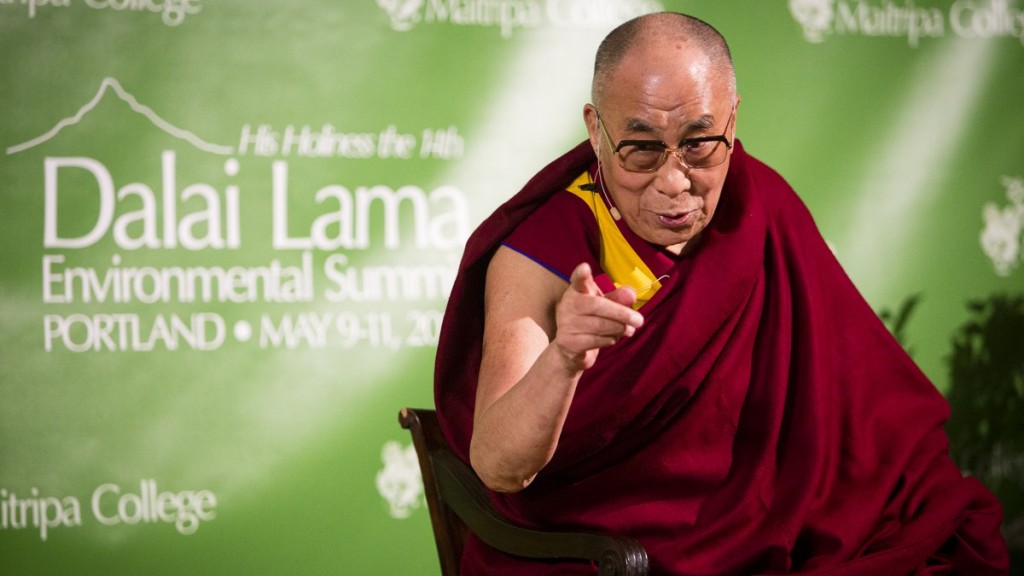
His Holiness the Dalai Lama at Maitripa College’s Dalai Lama Environmental Summit, Portland, Oregon, U.S., May 2013. Photo by Leah Nash.
“It’s very sad,” His Holiness the Dalai Lama told ABC News in April 2013, responding to questions about the reported role of Buddhist monks in violent and deadly attacks against Muslims in Myanmar (also known as Burma). “All the major religions teach us the practice of love, compassion and forgiveness. So a genuine practitioner among these different religious traditions would not indulge in such violence and bullying of other people.”
An April 2013 report by Human Rights Watch describes “the role of the Burmese government and local authorities in the forcible displacement of more than 125,000 Rohingya and other Muslims and the ongoing humanitarian crisis. Burmese officials, community leaders, and Buddhist monks organized and encouraged ethnic Arakanese backed by state security forces to conduct coordinated attacks on Muslim neighborhoods and villages in October 2012 to terrorize and forcibly relocate the population. The tens of thousands of displaced have been denied access to humanitarian aid and been unable to return home.”
ABC News asked what His Holiness would say to the Burmese Buddhist monks, if he had an opportunity to address them directly. “We are religious people,” His Holiness replied. “Buddha always teaches us about forgiveness, tolerance, compassion. If from one corner of your mind, some emotion makes you want to hit, or want to kill, then please remember Buddha’s faith. We are followers of Buddha.”
In May 2013, Reuters reported His Holiness called acts of violence perpetrated by Buddhist monks against Muslims in Myanmar “unthinkable.” “I think it is very sad,” he said, during a public talk at the University of Maryland, “I pray for them (the monks) to think of the face of Buddha.”
For more on human rights abuses in Burma, visits Human Rights Watch’s website.
- Tagged: burma, his holiness the dalai lama, mandala, myanmar
- 0
19
Ven. George Churinoff Finishes His Story with Lama Yeshe and Tenzin Ösel Hita
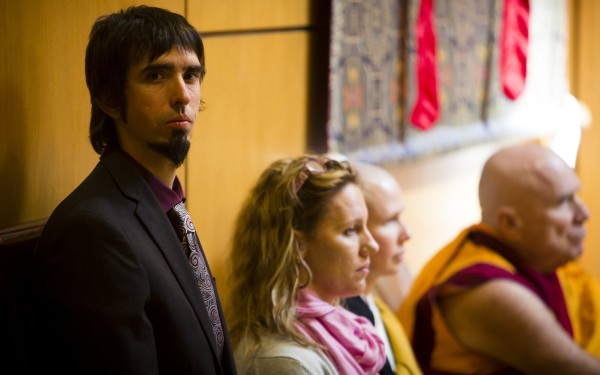
From left: Tenzin Ösel Hita, Namdrol Miranda Adams, Rev. Tenku Ruff and Ven. George Churinoff during His Holiness the Dalai Lama’s visit to Maitripa College, Portland, Oregon, U.S., May 10, 2013. Photo by Leah Nash.
For our April-June 2013 issue, Mandala asked Ven. George Churinoff to talk on the value of in-depth Buddhist study. He shared a story about some advice he had received from Lama Yeshe before setting off for the Geshe program at Manjushri Institute in the late 1970s. Unfortunately, our conversation was interrupted and not continued until May 2013, when Ven. George completed his story about Lama Yeshe and Buddhist study – and a very young Tenzin Ösel Hita – for the July-September 2013 issue.
Find the first part of the story “The Purpose of Study” as part of Mandala‘s April-June 2013 online content.
- Tagged: fpmt history, mandala
- 0
18
By Darren Littlejohn; Reviewed by Michael Jolliffe
In his earlier book, The 12-Step Buddhist, Darren Littlejohn, a recovering addict and student of Lama Zopa Rinpoche, offers a bridge between traditional 12-Step programs, which suffer from problematic terminology and pedagogy, and Buddhist teachings, which aren’t equipped to address some of the specific needs and concerns of the modern addict. Littlejohn’s newest work, The Power of Vow, accomplishes a similar synthesis, but specifically focuses on showing Buddhist and Buddhist-curious addicts “how to use sacred vows as tools that will help [them] find personal power.” Vows, for Littlejohn, help addict-practitioners grow into happier, healthier people.
Littlejohn writes The Power of Vow for what he calls the “neo-monastic,” that is, a committed Buddhist practitioner who is “low-key, under the radar, but working diligently to evolve.” Littlejohn’s neo-monastic by another term might just be “lay practitioner,” but his choice of phrasing highlights the tacit distinction between lay practitioners who merely claim so on their Facebook pages and lay practitioners that are committed and integrated in a more holistic way.
After a short introduction to basic Buddhist concepts (a summary of what was already covered in The 12-Step Buddhist), Littlejohn talks about what a vow is and how to make one. Next, he talks about the general types of vows – refuge, lay and bodhisattva – and provides a nuanced interpretation of what they entail while also making connections between the vows and the 12-steps. For example, when exploring the vow to not steal:
What do we take from others in the way of sympathy, attention, and affection? Anyone who’s done a searching and fearless moral inventory (Step 4) has likely touched a nerve about selfishness and self-centeredness. I think this vow is directly related.
As much as we’re thinking about ourselves, as most addicts do, we’re not considering others. I’m not advocating that we become obsessed with thinking of others to the degree that we aren’t taking care of ourselves. That would be more about codependency than the vow of not stealing. But there is plenty we can do to ease the burden of self-obsession, especially when we consider that it detracts from the happiness that others could be feeling. After all, if the self is really empty of inherent existence and only appears to be real, why would I be so self-absorbed as to ignore the happiness of others by taking what is not given? On the Buddhist path of vows, this is a thought that must stay with us as we develop.
The book ends with instructions on how to purify negative karma, what Littlejohn calls “the neutralizing of negative potentialities,” with traditional Tibetan Buddhist practices like recitation of the confession chapter of the Sutra of Golden Light, Vajrasattava visualization and mantra recitation, and prostrations. This section on purification also contains a helpful daily practice guide, which gives concrete instructions for addict-practitioners to start integrating vows into their daily lives.
Littlejohn, through The Power of Vow, has made at least two major contributions for which all addicts and non-addicts should be thankful. For adherents to the 12-Step model, Littlejohn’s work is another contribution to the growing number of alternative perspectives on a successful, although arguably dated system of recovery. For Buddhist addicts, Littlejohn has kindly – and without judgment – opened the door to a more fulfilling and happy life.
Published by Rainbow Light Media
Paperback US$12.62
Kindle eBook US$3.99
http://thepowerofvow.com
- Tagged: book reviews, darren littlejohn, mandala
- 1
12
Rejoicing in Other’s Inspiration
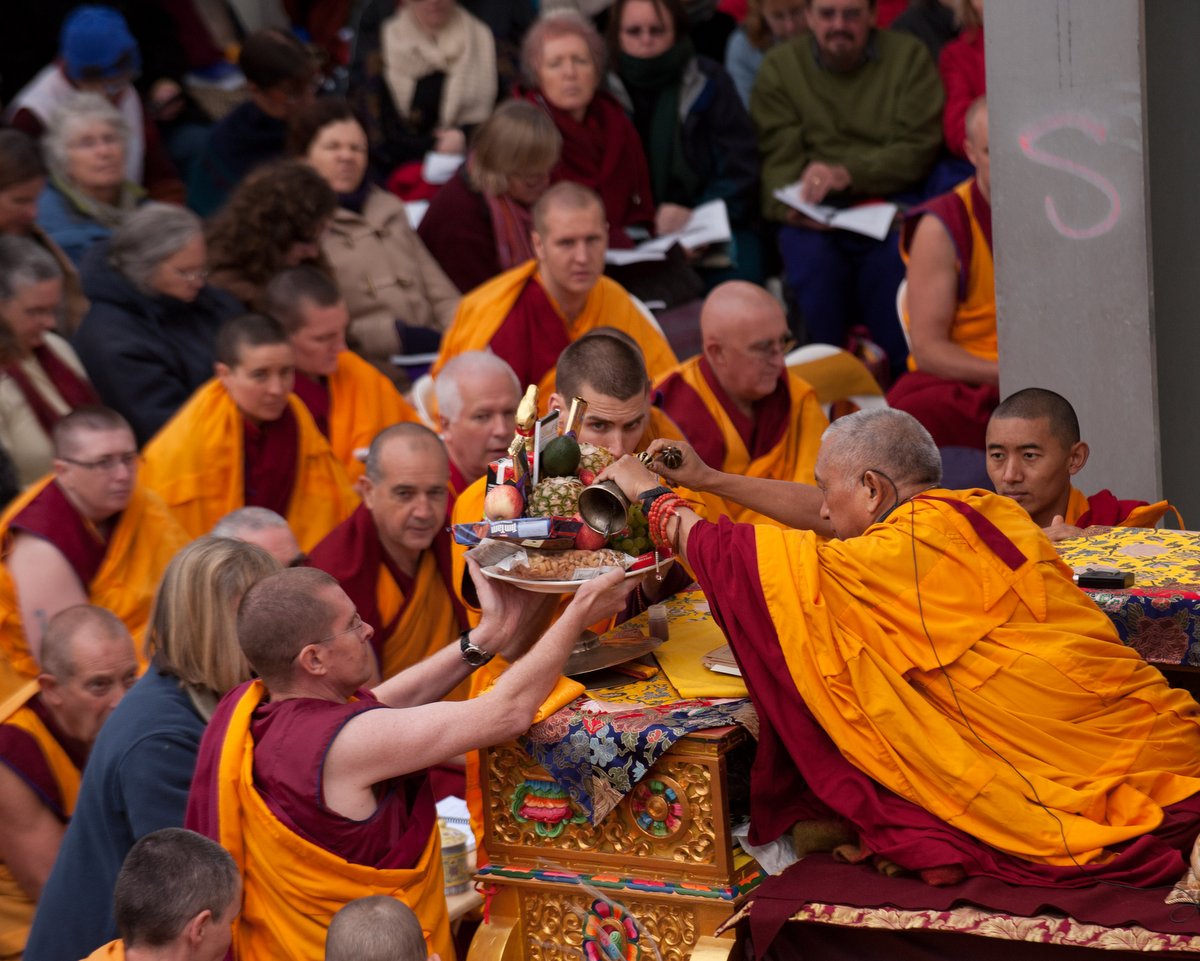
During the Australia 2011 retreat, Lama Zopa Rinpoche leading a puja in the unfinished Great Stupa of Universal Compassion, Victoria, Australia, March 2011. Photo by George Manos.
While leading a month-long retreat in Australia in March 2011 and just prior to manifesting a stroke, Lama Zopa Rinpoche received a card from a student attending the retreat. Rinpoche requested that the card be shared by Mandala so that others can rejoice:
Dearest Lama Zopa Rinpoche,
I just want to say how happy I am (all of us here, really), to have had the karma to spend time with you.
Your kindness and skill has inspired me to go back to the drawing board and totally change the life.
May I work tirelessly (as yourself) to fulfill the wishes of every sentient being and always Rinpoche abide in my heart.
Thank you for all the understanding, teachings and purification. I have not fulfilled all my commitments to you, but I will!
You can read more about the retreat, hosted by Atisha Centre, The Great Stupa of Universal Compassion and Thubten Shedrup Ling Monastery near Bendigo, Victoria, in the article “The Retreat of a Lifetime: Guru Devotion in Australia with Lama Zopa Rinpoche” from Mandala July-September 2011. In the same issue, Mandala covered Rinpoche’s stroke in “When the Guru Manifests a Stroke: Ordinary Appearances and Extraordinary Teachings from Lama Zopa Rinpoche.”
If you like what you read on Mandala, consider becoming a Friend of FPMT, which supports our work. Friends of FPMT at the Basic level and higher receive the print magazine Mandala, delivered quarterly to their homes.
10
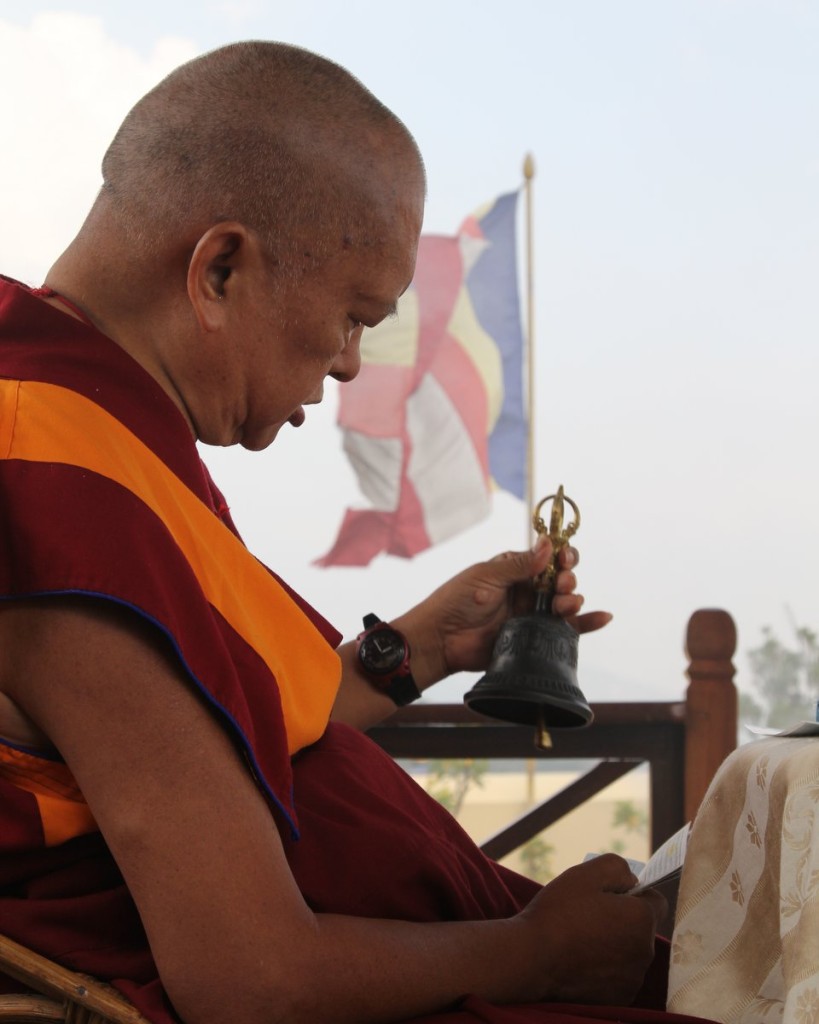
Lama Zopa Rinpoche doing incense puja at Kopan Monastery, Nepal, April 2013. Photo by Ven. Roger Kunsang.
While staying at Kopan Monastery in Nepal earlier this year, Lama Zopa Rinpoche gave an oral transmission of Lama Tsongkhapa’s Lekshe Nyingpo (Essence of True Eloquence). Here’s an edited extract from Rinpoche’s teaching before a transmission given in April 2013:
Lama Tsongkhapa mentioned that all the suffering in the world comes from ignorance; therefore the root of suffering is not outside. No matter how much scientific knowledge and education worldly people have they still believe the cause of suffering to be outside; but that’s wrong. The cause of suffering is in the mind and that’s why it is the mind that has to change. Changing the mind is more important than trying to change what’s outside; changing outside never finishes. Change has to come from the mind. It has to come from your mind.
The hell, hungry ghost and animal realms come from your mind, from your negative, impure mind and wrong way of thinking every moment and every day. While enlightenment, the fully awakened omniscient mind, liberation from samsara, and day-to-day happiness come from your mind and from the correct way of thinking, from positive thoughts. This is how everything comes from the mind.
For example, when you have problems in daily life, if you practice patience, compassion, thought transformation, bodhichitta, emptiness and so on, then at that time there are no more problems. In that hour and that minute when you change your mind and think differently the problems are gone. But when you don’t change your mind and keep thinking the old way, as people in the world generally do, believing that the root of suffering is outside even though they have so much scientific knowledge, well then the suffering never finishes. There is no end to suffering.
Lama Tsongkhapa mentioned that all the sufferings come from ignorance, but this is not just something stated by Lama Tsongkhapa; the more you learn Dharma and check scientifically, the more you discover and realize that this is true.
Excerpted from a teaching before a Lekshe Nyingpo lung at Kopan Monastery on April 13, 2013. Transcribed and edited by Ven. Sarah Thresher.
If you like what you read on Mandala, consider becoming a Friend of FPMT, which supports our work. Friends of FPMT at the Basic level and higher receive the print magazine Mandala, delivered quarterly to their homes.
- Tagged: lama zopa rinpoche, lekshe nyingpo, mandala, teachings and advice
- 0
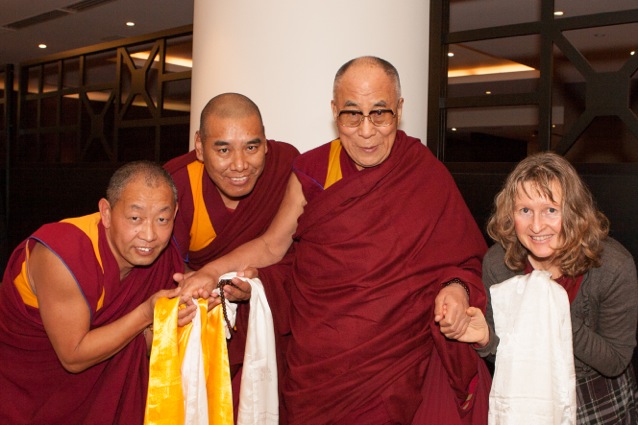
His Holiness the Dalai Lama with Geshe Wangdu, resident geshe Dorje Chang Institute; Geshe Jampa Tharchin, resident geshe Chandrakirti Centre; and Phillipa Rutherford, co-director Chandrakirti Centre, New Zealand, June 2013. Photo courtesy of Phillipa Rutherford.
During His Holiness the Dalai Lama’s tour of New Zealand, June 9-12, the resident geshes of the FPMT centers in New Zealand had their picture taken during a moment with His Holiness. Geshe Wangdu from Dorje Chang Institute and Geshe Jampa Tharchin from Chandrakirti Centre as well as Phillipa Rutherford, co-director of Chandrakirti Centre, posed for the photo.
About the visit, Phillipa Rutherford shared with Mandala:
His Holiness visited Christchurch, Dunedin and Auckland in New Zealand. The main theme of His Holiness teachings was secular ethics – bringing good conduct back into mainstream society – and how we can do this. His Holiness also visited two universities and spoke to hundreds of students.
This photo was taken at 5 a.m. at the hotel in Auckland. As His Holiness was leaving, he gave a short talk to the Tibetans, concluding with telling them to enjoy themselves while in the West.
From New Zealand, His Holiness toured Australia, June 14-23, visiting Sydney, Melbourne, Adelaide and Darwin. While in Sydney, His Holiness participated in the Young Minds conference, organized by Vajrayana Institute, the FPMT center in Sydney. In Melbourne, His Holiness spoke at Happiness & Its Causes, another project of Vajrayana Institute.
For reports on His Holiness’ activities in New Zealand and Australia, visit dalailama.com.
- Tagged: chandrakirti centre, dorje chang institute, geshe jampa tharchin, geshe kelsang wangdu, his holiness the dalai lama, mandala, new zealand, phillipa rutherford
- 0
3
A Very Profound Connection

David Suzuki with His Holiness the Dalai Lama, Portland, Oregon, U.S., May 2013. Photo by Leah Nash.
“Our fundamental needs are defined by our biological nature, by our social nature and by our spiritual nature,” Canadian scientist and environmentalist David Suzuki told Mandala in a recent interview. Suzuki was a panelist with His Holiness the Dalai Lama in May during Maitripa College’s Dalai Lama Environmental Summit.
“It just boggles my mind that we can put the economy above the very air that we need from the moment of our birth to the last breath we take before we die. That necessary exchange of air connects us with each other and every other terrestrial animal and plant on the planet. And it is a very, very profound connection,” Suzuki continued.
“My whole point is: there is no environment ‘out there’ that we have to regulate our interaction with. We literally are embedded in the air through the hydrologic cycle with water, with the earth through the food we eat, and through the energy in our bodies that comes from the Sun. We are literally made up of what aboriginal people call Mother Earth.”
Read more from this compelling interview with David Suzuki as part of Mandala‘s new online edition for the July-September 2013 issue.
If you like what you read on Mandala, consider becoming a Friend of FPMT, which supports our work. Friends of FPMT at the Basic level and higher receive the print magazine Mandala, delivered quarterly to their homes.
2
Practicing Real Dharma
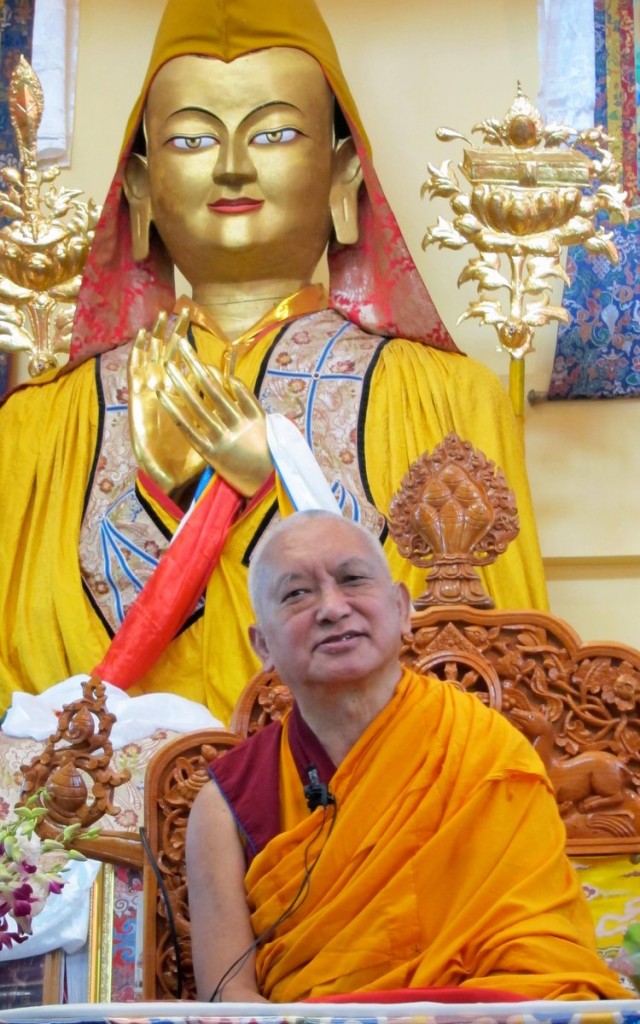
Lama Zopa Rinpoche teaching at Tushita Meditation Centre, McLeod Ganj, India, June 2013. Photo by Ven. Sarah Thresher.
“What a profound impact your book How to Practice Dharma: Teachings on the Eight Worldly Dharmas had on my mind,” a student writes FPMT spiritual director Lama Zopa Rinpoche. Rinpoche replies:
Skies of thanks for discovering Dharma and trying to practice Dharma with every action. Thank you very, very much. That’s the real Dharma. Even in the monasteries studying so much extensive philosophy, sometimes Dharma gets left out for some people. Looking like practicing Dharma but not practicing Dharma.
It is so precious what you have discovered, what you experienced. You discovered Dharma, what Dharma is. Numberless thanks again.
On Mandala‘s website, you can read two excerpt from Lama Zopa Rinpoche’s How to Practice Dharma: “The Dissatisfied Mind of Desire” and “Seeing Problems as Positive.” Lama Yeshe Wisdom Archive published How to Practice Dharma: Teachings on the Eight Worldly Dharmas, edited by Gordon McDougall, as part of their FPMT Lineage Series.
Here’s more from the inspiring letter written by the student to Lama Zopa Rinpoche:
I had read about the eight worldly dharmas before — numerous times. It never really impacted me like it did while reading your book. I wept and wept with the knowledge that after all these years of trying to learn the Dharma and thinking that I was making some progress practicing the Dharma that in reality I have never really practiced Dharma without the eight worldly dharmas controlling me. That awareness makes me cry now while writing to you — so much time has been wasted!
I scotched taped notes on my computer, phone, water jug, food pantry (and while I am writing to you, I am thinking of other ideas to place the post-its) with the word ‘motivation’ to remind me to check my ‘true motivation.’ I have written on a note card a prayer from your book that I say before I drive my car, before I read my holy Dharma books and before I begin my morning practice and night practice.
I am eternally grateful for you taking the time to write that book, for without it, I would have continued doing what I had always done … and wasted my entire life unknowingly.
Lama Yeshe Wisdom Archive publishes many of Lama Zopa Rinpoche’s letters in their “Lama Zopa Rinpoche Online Advice Book.” You can also keep up-to-date with news from the Archive through their monthly E-letter. The latest edition offers a teaching from Lama Yeshe called “Meditation on the Clarity of Mind.”
Lama Zopa Rinpoche’s letter was scribed by Ven. Sarah Thresher at Tushita Meditation Centre, McLeod Ganj, India, in June 2013. Both letters were lightly edited by Mandala.
- Tagged: eight worldly dharmas, lama zopa rinpoche, mandala
- 0
1
‘What makes you so peaceful?’
New from Mandala July-September 2013, Sarah Shifferd offers another installment of “Buddhist in the Trenches.” She writes:
Spring, 2008. Portland, Oregon. The sidewalk outside Fred Meyer. A young man shouts through a crowd of people getting off a bus.
“Hey! Hey! What makes you so peaceful?” I look up, confused. He pushes closer, his huge curly hair bobbing above the human chaos. He reaches me, out of breath. “Yeah!” He shouts again: “What makes you so peaceful?”
I don’t immediately find a convenient answer, so I search my mental hard drive for “Buddhism, peace, cause of …” I look up at the man and pause. He leans forward, panting slightly. I tell him about ethics, how living according to some basic precepts makes the mind more peaceful. I tell him it’s been true for me, that since I’ve been trying to do it, life has a lot less worry and anxiety and a lot more, well, peace. I explain that harming others disturbs the mind. I say something basic about karma. …
Read more from Sarah Shifferd’s piece “Shopping Buddha,” in the latest issue of Mandala.
28
Listen to His Holiness the Dalai Lama Discuss the Mind
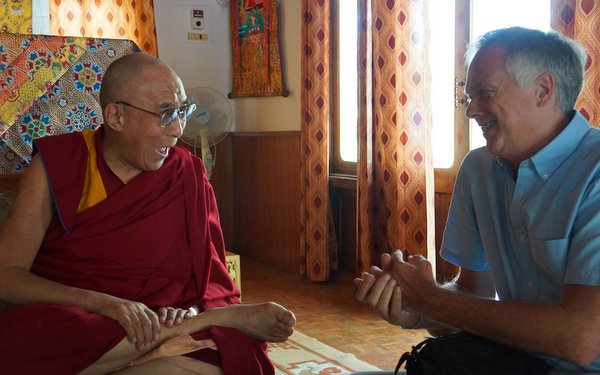
His Holiness the Dalai Lama speaking with Anthony Denselow, Ladakh, India, August 2012. Photo by Jeremy Russell.
As part of Mandala‘s July-September 2013 online edition, you can listen to His Holiness the Dalai Lama discussing the nature of the mind in five 15-minute audio segments. In concise fashion, His Holiness covers why we should study the mind, its nature and potential, and how we can change our minds for the better.
In August 2012 during a visit to Ladakh, India, His Holiness spoke with radio producer Anthony Denselow, a Kopan alumnus and student of Jamyang Buddhist Centre’s Geshe Tashi. Denselow produced a piece based on the interview with His Holiness for BBC Radio 4 and also shared these five illuminating audio segments with Mandala.
If you like what you read on Mandala, consider becoming a Friend of FPMT, which supports our work. Friends of FPMT at the Basic level and higher receive the print magazine Mandala, delivered quarterly to their homes. Become a Friend by the end of June and receive the new July-September 2013 issue.
26
Meet Chokyi Gyaltsen Center’s Geshe Deyang
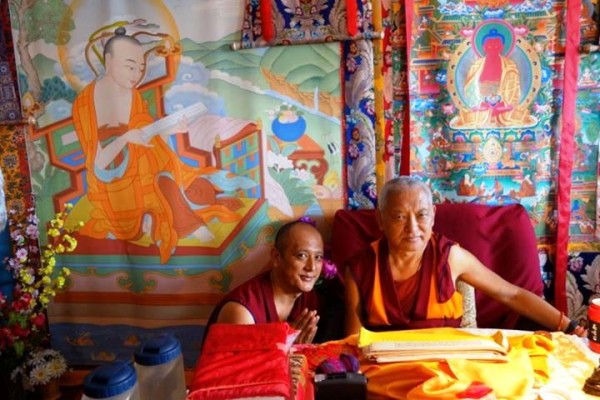
Lama Zopa Rinpoche with Geshe Deyang, resident geshe of Chokyi Gyaltsen Center, Kopan, Nepal, May 2013. Photo by Ven. Roger Kunsang.
In a new video, made at the request of Mandala and the students of Chokyi Gyaltsen Center, Geshe Deyang – resident geshe for Chokyi Gyaltsen Center, the FPMT center in Penang, Malaysia – talks about his background and education.
You can watch the video as part of Mandala’s July-September 2013 online content.
Geshe Deyang has served as the resident geshe for Losang Dragpa Centre, also in Malaysia. Ven. Sherab from Losang Dragpa Centre kindly provided interpretation for the video.
If you like what you read on Mandala, consider becoming a Friend of FPMT, which supports our work. Friends of FPMT at the Basic level and higher receive the print magazine Mandala, delivered quarterly to their homes. Become a Friend by the end of June and receive the new July-September 2013 issue.
- Tagged: mandala, your community
- 0
- Home
- News/Media
- Study & Practice
- About FPMT Education Services
- Latest News
- Programs
- New to Buddhism?
- Buddhist Mind Science: Activating Your Potential
- Heart Advice for Death and Dying
- Discovering Buddhism
- Living in the Path
- Exploring Buddhism
- FPMT Basic Program
- FPMT Masters Program
- FPMT In-Depth Meditation Training
- Maitripa College
- Lotsawa Rinchen Zangpo Translator Program
- Universal Education for Compassion & Wisdom
- Online Learning Center
- Prayers & Practice Materials
- Overview of Prayers & Practices
- Full Catalogue of Prayers & Practice Materials
- Explore Popular Topics
- Benefiting Animals
- Chenrezig Resources
- Death & Dying Resources
- Lama Chopa (Guru Puja)
- Lama Zopa Rinpoche: Compendium of Precious Instructions
- Lama Zopa Rinpoche: Life Practice Advice
- Lama Zopa Rinpoche Practice Series
- Lamrim Resources
- Mantras
- Prayer Book Updates
- Purification Practices
- Sutras
- Thought Transformation (Lojong)
- Audio Materials
- Dharma Dates – Tibetan Calendar
- Translation Services
- Publishing Services
- Teachings and Advice
- Find Teachings and Advice
- Lama Zopa Rinpoche Advice Page
- Lama Zopa Rinpoche: Compendium of Precious Instructions
- Lama Zopa Rinpoche Video Teachings
- ༧སྐྱབས་རྗེ་བཟོད་པ་རིན་པོ་ཆེ་མཆོག་ནས་སྩལ་བའི་བཀའ་སློབ་བརྙན་འཕྲིན།
- Podcasts
- Lama Yeshe Wisdom Archive
- Buddhism FAQ
- Dharma for Young People
- Resources on Holy Objects
- Ways to Offer Support
- Centers
- Affiliates Area
- Teachers
- Projects
- Charitable Projects
- Make a Donation
- Applying for Grants
- News about Projects
- Other Projects within FPMT
- Support International Office
- Projects Photo Galleries
- Give Where Most Needed
- FPMT
- Shop
Subscribe to FPMT News
Translate*
*powered by Google TranslateTranslation of pages on fpmt.org is performed by Google Translate, a third party service which FPMT has no control over. The service provides automated computer translations that are only an approximation of the websites' original content. The translations should not be considered exact and only used as a rough guide.It’s the foggy mind, the mind that’s attracted to an object and paints a distorted projection onto it, that makes you suffer. That’s all. It’s really quite simple.







